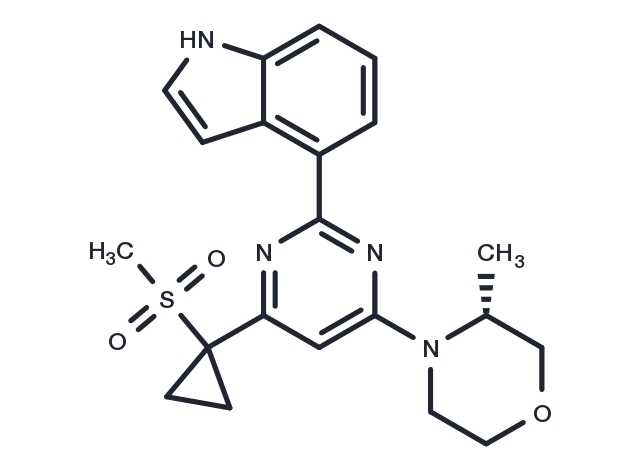Powder: -20°C for 3 years | In solvent: -80°C for 1 year
AZ20 is an effective and specific inhibitor of ATR kinase (IC50: 5 nM, in a cell-free assay), 8-fold selectivity over mTOR.

| パッケージサイズ | 在庫状況 | 単価(税別) | |||
|---|---|---|---|---|---|
| サンプルについてお問い合わせ | |||||
| 2 mg | 在庫あり | ¥ 7,500 | |||
| 5 mg | 在庫あり | ¥ 12,000 | |||
| 10 mg | 在庫あり | ¥ 18,500 | |||
| 25 mg | 在庫あり | ¥ 33,500 | |||
| 50 mg | 在庫あり | ¥ 60,000 | |||
| 100 mg | 在庫あり | ¥ 89,000 | |||
| 1 mL * 10 mM (in DMSO) | 在庫あり | ¥ 12,500 | |||
| 説明 | AZ20 is an effective and specific inhibitor of ATR kinase (IC50: 5 nM, in a cell-free assay), 8-fold selectivity over mTOR. |
| ターゲット&IC50 | mTOR:38 nM, ATR:5 nM |
| In vitro | AZ20 (10 μM) inhibits 50% of the metabolism of midazolam mediated by CYP3A4. In female nude mice with LoVo tumors, treatment with AZ20 (25 mg/kg, twice daily, orally; or 50 mg/kg/day, orally) for 13 days significantly suppresses tumor growth. This effect is associated with a sustained and extensive increase in γH2AX nuclear staining in xenografted tissues. |
| In vivo | In vitro, the concentration of AZ20 correspondingly decreases the levels of pChk1 Ser345/317/296. Extending the treatment duration with AZ20 intensifies γH2AX nuclear staining due to replication stress, associated with S phase arrest and an increase in histone H3 phosphorylation levels. The ability of AZ20 to inhibit cellular growth and induce cell death is entirely distinct from other cytotoxic drugs. The cytotoxic effects are enhanced when AZ20 is used in combination with the ATM inhibitor KU-60019. |
| キナーゼ試験 | ATR for use in the in vitro enzyme assay is obtained from HeLa nuclear extract by immunoprecipitation with rabbit polyclonal antiserum raised to amino acids 400-480 of ATR contained in the following buffer: 25 mM HEPES (pH 7.4), 2 mM MgCl2, 250 mM NaCl, 0.5 mM EDTA, 0.1 mM Na3VO4, 10% v/v glycerol, and 0.01% v/v Tween 20. ATR-antibody complexes are isolated from nuclear extract by incubating with protein A-Sepharose beads for 1 h and then through centrifugation to recover the beads. In the well of a 96-well plate, 10 μL ATR-containing Sepharose beads are incubated with 1 μg of substrate glutathione?S-transferase-p53N66 (NH2-terminal 66 amino acids of p53 fused to glutathione?S-transferase are expressed in?E. coli) in ATR assay buffer (50 mM HEPES (pH 7.4), 150 mM NaCl, 6 mM MgCl2, 4 mM MnCl2, 0.1 mM Na3VO4, 0.1 mM DTT, and 10% (v/v) glycerol) at 37°C in the presence or absence of inhibitor. After 10 min with gentle shaking, ATP is added to a final concentration of 3 μM and the reaction continued at 37°C for an additional 1 h. The reaction is stopped by addition of 100 μL of PBS, and the reaction is transferred to a white opaque glutathione coated 96-well plate and incubated overnight at 4°C. This plate is then washed with PBS/0.05% (v/v) Tween 20, blotted dry, and analyzed by a standard ELISA technique with a phosphoserine 15 p53 antibody. The detection of phosphorylated glutathione?S-transferase-p53N66 substrate is performed in combination with a goat anti-mouse horseradish peroxidase-conjugated secondary antibody. Enhanced chemiluminescence solution is used to produce a signal, and chemiluminescent detection is carried out via a TopCount plate reader. The resulting calculated % enzyme activity is then used to determine the IC50?values for the compounds (IC50?taken as the concentration at which 50% of the enzyme activity is inhibited). |
| 細胞研究 | AZ20 is dissolved in 100% DMSO. Compound dose ranges are created by diluting in 100% DMSO and then further into assay medium (EMEM, 10% FCS, 1% glutamine) using a Labcyte Echo acoustic dispensing instrument. Cells are plated in 384-well Costar plates at 9×104?cells per mL in 40 μL of EMEM, 10% FCS, 1% glutamine and grown for 24 h. Following addition of compound the cells are incubated for 60 min. A final concentration of 3 μM?4NQO?(prepared in 100% DMSO) is then added using the Labcyte Echo, and the cells are incubated for a further 60 min. The cells are fixed by adding 40 μL of 3.7% v/v formaldehyde solution for 20 min. After removal of fix, cells are washed with PBS and permeabilized in 40 μL of PBS containing 0.1% Triton X-100. The cells are then washed, and 15 μL primary antibody solution (pChk1 Ser345) is added. The plates are incubated at 4°C overnight. The primary antibody is then washed off, and 20 μL of secondary antibody solution and 1 μM Hoechst 33258 added for 90 min at room temperature. The plates are washed and left in 40 μL of PBS. Plates are then read on an ArrayScan VTI instrument to determine staining intensities, and dose responses are obtained and used to determine the IC50?values for the compounds. |
| 分子量 | 412.51 |
| 分子式 | C21H24N4O3S |
| CAS No. | 1233339-22-4 |
Powder: -20°C for 3 years | In solvent: -80°C for 1 year
Ethanol: 3 mg/mL (7.27 mM)
H2O: < 1 mg/mL (insoluble or slightly soluble)
DMSO: 77 mg/mL (186.7 mM)
You can also refer to dose conversion for different animals. 詳細
bottom
Please see Inhibitor Handling Instructions for more frequently ask questions. Topics include: how to prepare stock solutions, how to store products, and cautions on cell-based assays & animal experiments, etc.
AZ20 1233339-22-4 DNA Damage/DNA Repair PI3K/Akt/mTOR signaling ATM/ATR mTOR Ataxia telangiectasia mutated inhibit AZ-20 ATM and RAD3 related Inhibitor AZ 20 inhibitor
